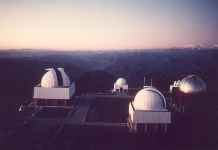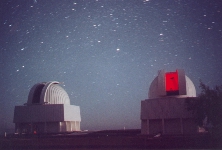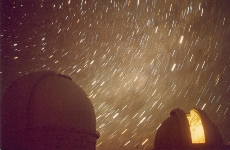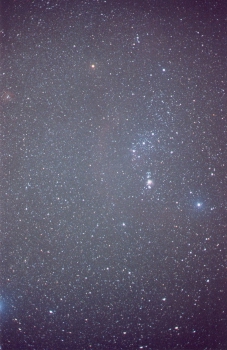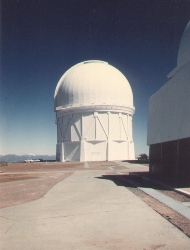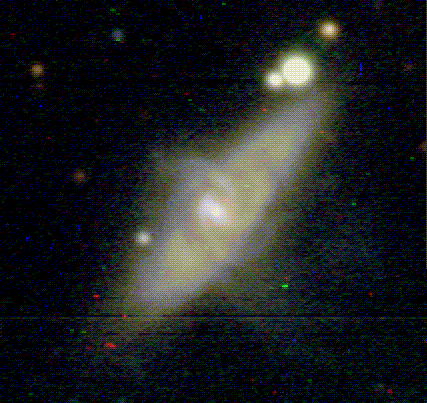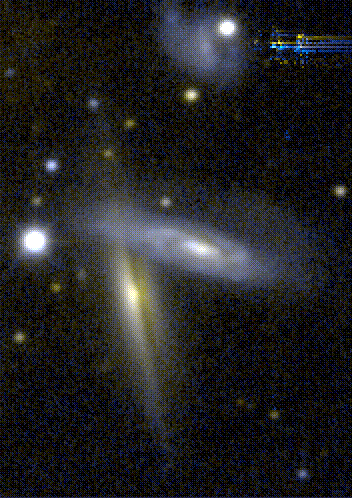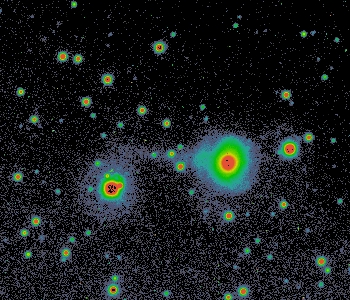Telescopes I've Used - Cerro Tololo Inter-American Observatory
Cerro Tololo
Inter-American Observatory, Cerro Tololo, IVa Region, Chile
 The southern-hemisphere counterpart to Kitt Peak,
Cerro Tololo is situated in
the foothills of the Andes, above the Elqui River valley inland of La Serena.
As seen in this aerial view, Cerro Tololo isn't a very impressive summit
compared to the spine of the Andes, but it's high enough for good seeing
and not high enough for really severe weather (yeah, I can say that, not having
been one of the astronomers who had to walk down off the mountain following
a July blizzard).
The site has spectacularly dark skies, supporting studies of galactic structure
and the Magellanic Clouds in particular, as well as that part of the deep
extragalactic Universe that isn't accessible to the more numerous Northern
Hemisphere facilities. The flat mountaintop is very crowded, with the 4-m,
1.5m, 0.9m Curtis Schmidt, 1.0m (former Yale), 0.9m, and two domes for 0.4m
instruments, so that the new SOAR and Gemini-South projects are being erected
on nearby Cerro Pachon, affording much more real estate as well as probably
better airflow and seeing. Several visitors have remarked that the Maya-style
buildings and their east-west alignments give a particularly mystical
aura to the mountaintop. (Before I hear complaints, yes, I know that the
Maya were thousands of miles north on a different continent - but I
didn't invent this stuff.)
The southern-hemisphere counterpart to Kitt Peak,
Cerro Tololo is situated in
the foothills of the Andes, above the Elqui River valley inland of La Serena.
As seen in this aerial view, Cerro Tololo isn't a very impressive summit
compared to the spine of the Andes, but it's high enough for good seeing
and not high enough for really severe weather (yeah, I can say that, not having
been one of the astronomers who had to walk down off the mountain following
a July blizzard).
The site has spectacularly dark skies, supporting studies of galactic structure
and the Magellanic Clouds in particular, as well as that part of the deep
extragalactic Universe that isn't accessible to the more numerous Northern
Hemisphere facilities. The flat mountaintop is very crowded, with the 4-m,
1.5m, 0.9m Curtis Schmidt, 1.0m (former Yale), 0.9m, and two domes for 0.4m
instruments, so that the new SOAR and Gemini-South projects are being erected
on nearby Cerro Pachon, affording much more real estate as well as probably
better airflow and seeing. Several visitors have remarked that the Maya-style
buildings and their east-west alignments give a particularly mystical
aura to the mountaintop. (Before I hear complaints, yes, I know that the
Maya were thousands of miles north on a different continent - but I
didn't invent this stuff.)
Whenever the opportunity presented itself, I've sneaked over to the
0.4m telescope dome (little used these days)
and used it for piggyback photography and that perennial favorite of NOAO
proposers, visual observations of deep-sky objects. Here are some samples of
how dark and clean the sky can be in Chile, limited by my cheap scanner.
There's also a nice
wide-field view of
the Galactic Center taken from
a 35mm slide.
One bit of wildlife at Cerro Tololo that is especially impressive to
most of us is the condors. On most days, at least one can be seen
wheeling, gliding for what seems like hours with only slight trim
to the wingtip feathers. Occasionally some of the cooks will throw
one a whole chicken. It's attention-getting to hear a rapping on the
dining-room window, turn around, and see a bird looking you right
in the eye. Also noteworthy are vizcachas, which look at first like
large grey rabbits until you notice the long, bushy tail and
squirrel-like movements. They have a particular habit of appearing
at sunset, giving every impression of thoughtfully contemplating
sundown from a rocky perch.

4-m Victor Blanco telescope
I used this instrument for imaging and spectroscopic studies of optical jets
(and candidate jets, most of which don't pan out). As examples, here's one of
the mysterious jets from the barred spiral galaxy NGC 1097, in a summed
B+V mosaic shown in pseudocolor covering the area where the northwest
jet takes a corner (the galaxy core is several field areas away to the
lower right). After adding VLA observations, spectroscopic
limits on emission lines, and some soul-searching, several of us
concluded that the jets in this case are most likely starlight,
perhaps from particularly odd tidal interactions with the close elliptical
companion to NGC 1097. Or maybe not.
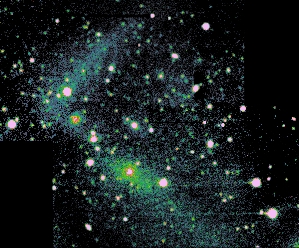
For comparison, here is a color-composite image of the nucleus of
NGC 1097, showing the central ring of star formation (which must be more
elliptical than it appears, to lie in the plane of the galaxy), inner bar with
prominent dust lanes, and central old stellar population (within which an
active nucleus comes and goes, as seen spectroscopically). This was made
from short-exposure
B and V CCD frames with the Blanco 4m prime-focus camera.
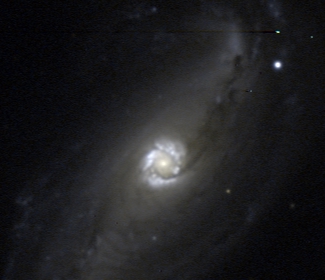
1.5m telescope
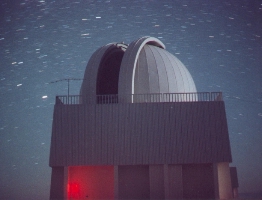
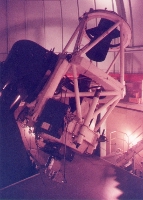 For a decade the largest instrument at CTIO, this telescope is unusually
well-equipped
for its aperture. We've used it for identification of faint IRAS galaxies, and
recently as a major part of the study Ray White III and I have done of dust in
galaxies through the use of overlapping galaxy pairs. There's a law of nature
which decrees that the most interesting galaxies in our part of the Universe
are found at deep southern declinations. This instrument furnished our best
set of overlapping galaxies, of which a couple are illustrated here.
I also used it as part of
a survey for possible optical jets in southern galaxies, which mostly turned
up odd tidal features. A couple of examples are shown here in pseudocolor
renditions of V-band images.
For a decade the largest instrument at CTIO, this telescope is unusually
well-equipped
for its aperture. We've used it for identification of faint IRAS galaxies, and
recently as a major part of the study Ray White III and I have done of dust in
galaxies through the use of overlapping galaxy pairs. There's a law of nature
which decrees that the most interesting galaxies in our part of the Universe
are found at deep southern declinations. This instrument furnished our best
set of overlapping galaxies, of which a couple are illustrated here.
I also used it as part of
a survey for possible optical jets in southern galaxies, which mostly turned
up odd tidal features. A couple of examples are shown here in pseudocolor
renditions of V-band images.
Telescope Collection
Bill Keel's Home Page |
Astronomical Image Gallery |
Image Usage and Copyright Info |
UA Astronomy
keel@bildad.astr.ua.edu
Last changes: 8/2001 © 1999-2001
 The southern-hemisphere counterpart to Kitt Peak,
Cerro Tololo is situated in
the foothills of the Andes, above the Elqui River valley inland of La Serena.
As seen in this aerial view, Cerro Tololo isn't a very impressive summit
compared to the spine of the Andes, but it's high enough for good seeing
and not high enough for really severe weather (yeah, I can say that, not having
been one of the astronomers who had to walk down off the mountain following
a July blizzard).
The site has spectacularly dark skies, supporting studies of galactic structure
and the Magellanic Clouds in particular, as well as that part of the deep
extragalactic Universe that isn't accessible to the more numerous Northern
Hemisphere facilities. The flat mountaintop is very crowded, with the 4-m,
1.5m, 0.9m Curtis Schmidt, 1.0m (former Yale), 0.9m, and two domes for 0.4m
instruments, so that the new SOAR and Gemini-South projects are being erected
on nearby Cerro Pachon, affording much more real estate as well as probably
better airflow and seeing. Several visitors have remarked that the Maya-style
buildings and their east-west alignments give a particularly mystical
aura to the mountaintop. (Before I hear complaints, yes, I know that the
Maya were thousands of miles north on a different continent - but I
didn't invent this stuff.)
The southern-hemisphere counterpart to Kitt Peak,
Cerro Tololo is situated in
the foothills of the Andes, above the Elqui River valley inland of La Serena.
As seen in this aerial view, Cerro Tololo isn't a very impressive summit
compared to the spine of the Andes, but it's high enough for good seeing
and not high enough for really severe weather (yeah, I can say that, not having
been one of the astronomers who had to walk down off the mountain following
a July blizzard).
The site has spectacularly dark skies, supporting studies of galactic structure
and the Magellanic Clouds in particular, as well as that part of the deep
extragalactic Universe that isn't accessible to the more numerous Northern
Hemisphere facilities. The flat mountaintop is very crowded, with the 4-m,
1.5m, 0.9m Curtis Schmidt, 1.0m (former Yale), 0.9m, and two domes for 0.4m
instruments, so that the new SOAR and Gemini-South projects are being erected
on nearby Cerro Pachon, affording much more real estate as well as probably
better airflow and seeing. Several visitors have remarked that the Maya-style
buildings and their east-west alignments give a particularly mystical
aura to the mountaintop. (Before I hear complaints, yes, I know that the
Maya were thousands of miles north on a different continent - but I
didn't invent this stuff.)